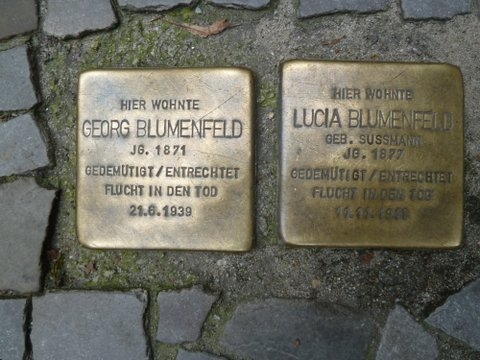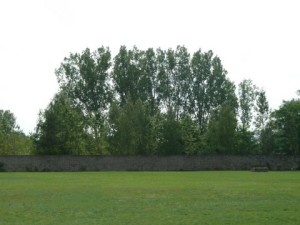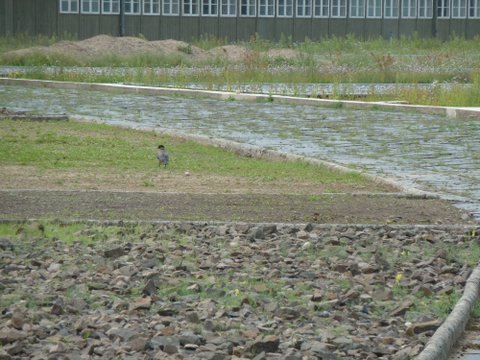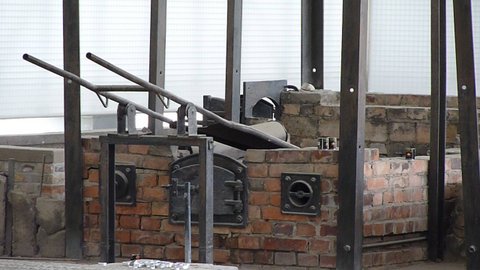On a recent trip to Berlin I visited KZ Sachsenhausen, a former Nazi concentration camp located just an hour north of the city. It was a beautiful day—high summer in Berlin, in the mid-seventies with a slight breeze—and the treetops, visible over the camp’s reconstructed fence, bobbed in the wind. The tour bus pulled into a large gravel parking lot across from tidy stucco houses with drawn blinds and trimmed gardens. An older man dressed in shorts and an open shirt rummaged around in his tool shed and emerged with a pair of gardening shears. It might have been a New Jersey suburb on a Saturday morning.
Inside the camp, our group—American Jews in their twenties with an interest in Germany and transatlantic relations—gathered in a small lecture room to watch a slideshow on the history of the camp. Established on the outskirts of the city in 1936, three years after Hitler was elected chancellor, Sachsenhausen first held political dissidents, mainly communists, and other undesirables, including gays, drunks, and homeless people. Berlin was Vice City in the twenties and thirties, with flapper girls, indigent war veterans, junkies, pimps and prostitutes—German Expressionist painter Otto Dix captured the scene—and for the Nazi party to keep its promise of restoring order in the capital city, it needed a place to deposit all the riffraff. The camp was arranged in a broad triangle on green farmland. Prisoners were kept at the triangle’s narrow end, with the guards’ barracks and administrative buildings occupying the wider and more spacious section of the camp. The elite corps that would eventually be known as the SS was organized and trained there. At Sachsenhausen, camp boss and future commandant at Auschwitz Rudolf Höss carried out his brutal “masterpiece”—a three-hour roll-call in freezing temperatures one winter. Today, the former SS section of the camp is a functioning police academy.
As time passed, Jews began to outnumber communists at Sachsenhausen, and when war broke out, the place became a work camp where prisoners assembled shoes, textiles, and armaments. For a time it was also a Soviet prisoner-of-war camp where over 10,000 Soviet soldiers were executed and buried in a massive pit scooped out of the sandy soil, their bodies burned in still modestly sized crematoria. By war’s end, any remaining Jews were deported from Sachsenhausen to “annihilation” camps in the East, where the Germans killed as many and as quickly as they could, as if its nearing demise provoked a kind of vicious death spasm throughout the Third Reich.
That is a vague sketch of the phases of the camp, its origins and growth from a few acres into an expanse many football fields wide, and later its decrease in size and near-disappearance. When the war ended, starving Germans scavenged the campsite for building materials: bricks to prop up tiny shacks and firewood for warmth and cooking.
As a memorial site Sachsenhausen is yet unfinished. During the Cold War the Soviets chose to remember the camp as a place where Soviet collectivism triumphed over fascism, so they erected a massive concrete pillar in the middle of the prison grounds with an inscription to this effect. They made no mention of the Jews or Sinti who died there, or any of the other victims. As a counterpoint to the pillar, alongside a grey wall, the museum has a few written displays that tell the viewer who an individual prisoner was, how and when he or she arrived at the camp, what the person carried in, and when he or she died. Because of Sachsenhausen’s proximity to Berlin, more and more visitors make the trip each year, and one senses that the museum’s curators are still deciding what to do with the space. Walking around the grass and gravel, one feels a bleak rural randomness—a sentry post, like a pagoda on stilts, almost blending into the green canvas of the surrounding trees; a painter’s scaffold to touch up a section that is chipping; backhoes and other earthmoving machines amid long sections of grey chainlink fence as if an old farming estate were being converted into a temporary outdoor music venue.
To escape the disorder of the place, the slow shuffling of our 35-member group, and the obligatory solemnity that had imperceptibly osmosed into a real feeling of depression, I ducked down a narrow path following a sign for the bathrooms and in the same cluster of buildings came upon a small library.
The librarian, chatting with two other visitors when I entered, barely noticed me. I browsed a moment and then sat down at a long Formica table to read. Books, composed of sentences and space, have as much design and architecture as do physical structures like train stations, cities, and concentration camps. Consciously or not, I was seeking refuge in reading, in the comforting rhythm of words following words toward some meaning at the end. The book I had been toting around in my backpack for weeks was a memoir by Boris Pahor, a Slovenian Holocaust survivor. A small black rectangle barely two-hundred pages long, Necropolis(Champaign, Ill., 2010; all quotations from Pahor are drawn from this edition) begins in present times, with Pahor hanging on to the end of a tour group at Natzweiler-Stuthof, a former concentration camp in the Vosges Mountains where he was imprisoned in 1944 for activity in the Yugoslavian Resistance movement in Trieste. Like a fishing float loosely attached to its rod, Pahor keeps his distance from the tour group, distracting himself with some of the physical aspects of the refurbished camp: the brickwork of the barracks, the rusty knots of a barbed-wire fence. Feeling guilty for having survived when so few others did, Pahor leads the reader through Necropolis, his dead city of memories and friends, at the same time he is led through the camp-cum-memorial by various tour guides. Crucially, Pahor was imprisoned as a political adversary, not as a Jew, and his ability to speak and translate German into Slavic and Romance languages qualified him for work assisting a Norwegian doctor, and likely saved his life. As a side note, Primo Levi has remarked that growing up in Italy, he never identified as Jewish until he was deported to a concentration camp where, like Pahor, Levi’s ability to speak German landed him a job in a chemical factory at Auschwitz. Of the other Italian Jews who spoke no German, Yiddish, or Russian, most died quickly. Although we meet some of the people whom Pahor befriended and worked with, Necropoliscontains little of the wrenching vignettes found in Primo Levi’s memoir, The Drowned and the Saved, and none of the searing rage that makes the essays of Jean Améry, an AustrianHolocaust memoirist, so devastating. Instead, Necropolis is disjointed in time and place; it meanders along with voids in explanation and without a discernible message or strong emotion. Even so, sitting in the empty library at Sachsenhausen, I read lines and passages in Pahor’s memoir that enveloped me totally.
In one section, Pahor describes an evacuation of prisoners from one camp to another. He is in the infirmary helping the very sick get onto thin stained mattresses and then piling them onto the beds of trucks. The weather is freezing and many are so weak they will expire on the short trip from the barracks to the waiting van. In the madness Pahor looks in on a young Czech boy whose “long stubbornness had been an unexpected consolation for me.” Pahor wonders whether it wouldn’t be “better for the boy to rest under a soft layer of earth” instead of dying under a pile of mattresses and bodies. When Pahor reaches the boy, deep purple bruises are around his neck. While Pahor was loading others on the truck, the camp doctor had tried, without explanation, to strangle the boy to death. “All the young Czech could do was open his mouth from time to time and pucker his lips like a beached fish unsure whether the sea existed anymore.” Pahor delivers a staggering metaphor describing the young prisoner’s last loneliness.
Abruptly we are back in the present time in Necropolis. The people from Pahor’s previous tour have been replenished by a new group of visitors and Pahor joins up casually. He is loitering, only half attached like a shy child in a playground or an old man on a bench. When the tour guide leads the visitors into a prisoners’ barrack, Pahor sees something both familiar and confusing. Two girls are helping a limping man up the few steps into the barrack. “As he raises the lame foot from one step to the next, he leans on the girls with all his weight. A picture reminiscent of the camp, except that no one helped the cripples back then.” Later, the sound of gravel underfoot reverberates in Pahor’s memory, but the sound he remembers—wooden clogs on gravel—is “harsher, more hollow.”
Later in the book Pahor relates one of the most surreal aspects of imprisonment, the seemingly normal, even quotidian tasks prisoners carry out during their terms: doing the laundry, laying bricks, repaving a stretch of road in a quiet town. The passage reminded me of drives I have taken in rural areas when I come upon a group of workers clearing brush by the roadside. They are dressed in bright orange jumpsuits that read across the backDepartment of Correction. The semblance of real work and real life crashes up against the prisoner’s utterly un-free reality and creates a jarring psychological dissonance. Peter Fischl, a fifteen-year-old boy at Terezin, made the point poetically. His words underscore the odd and arbitrary routines of prison life:
We got used to standing in line at seven o’clock in the morning, at 12 noon and again at seven o’clock in the evening. We stood in a long queue with a plate in our hand, into which they ladled a little warmed up water with a salty or coffee flavor. Or else they gave us a few potatoes. We got used to sleeping without a bed, to saluting every uniform, not to walk on the sidewalks and then again to walk on the sidewalks. . . . We got used to that fact that from time to time, one thousand unhappy souls would come here and that, from time to time, another thousand unhappy souls would go away. (A Passover Haggadah, ed. Herbert Bronstein [New York, 1974], 41.)
Fischl died in Auschwitz in 1944.
In similar fashion, one of the most powerful passages in Necropolis concerns Pahor’s nighttime trip to a coal mine near the Harzungen camp in central Germany, where able-bodied inmates were worked to exhaustion. Jupp, a Dutch prisoner and friend, had diarrhea, and Pahor agreed to work in his place so that he might have a night’s rest to recuperate:
That night I left the camp in his place. The snow shone metallic in the dark. As I walked I was overcome by a wave of uncertainty and desperate nostalgia for my little nook in death’s antechamber. But then I was distracted by the marching of our formations, which for a while appeared like rows of real workers. But when we came within earshot of the shouting and the searchlights, that illusion vanished. . . . At the front of the column a shriek would pierce the cold air, and be repeated like the caws of countless crazed ravens. It was the Germans, our hidden shepherds, shouting to draw a fence of fear around the herd as it hobbled and tripped in the north wind.
The alliteration in the three phrases, “caws of countless crazed ravens,” “fence of fear,” and “shepherds shouting,” give the passage a stuttering rhythm of almost musical quality, as if the entire work brigade, guards included, is a kind of perverse music ensemble rehearsing in the deaf winter landscape.
The surreal night goes on and Pahor recalls it in poignant detail, remembering the men, the cold, the darkness:
The procession stopped in front of a long line of steel carts. Bodies climbed up, levering themselves with arms and legs, and for a moment remained suspended over the steel edge before finally sliding inside the huge, Krupp-manufactured carts, the kind that miners fill with ore. Then night swallowed the last flashlight beams, and the steel boxes jolted, grated, and started rolling. As at a signal, snow began to fall. The small engine gave off puffs of warm steam, and arms and legs longed to reach that skybound warmth.
Pahor’s almost fantastical trip to the mine—As at a signal, snow began to fall—reminds one of Primo Levi’s sublime short stories. In “One Night,” a mysterious train breaks down in the desolate woods and is set upon by villagers, who diligently, but without reason, dismantle the train. Cars, tracks, engine, wheels are all separated in silence. They then senselessly destroy themselves, rending clothes from bodies, limbs from torsos, and shoes from feet until all is dispersed and discarded in the leaf-litter. The story ends with the image of a tranquil forest and suggests the alternating rhythms of traumatic violence: as forceful as a train, as still as an undisturbed place where one questions whether anything actually happened there.
Levi’s bizarre story and Pahor’s eerie nighttime trip are not without historical complement. Indeed, in 1944, when the war was ending, the Nazis tried to erase evidence of what had transpired in the camps. Fences were dismantled, documents burned, and prisoners were taken on “death marches” to more secure camps elsewhere. Unmarked sites of genocide in Eastern Europe still appear, and the construction of a new mall or a soccer field has been delayed by the discovery of mass graves. “Humiliated bones,” Pahor says, when he considers how few people in Europe care about what happened, how tired they are of hearing about it and being made to feel something. “Europe,” he writes, fitted itself with “glass eyes so it wouldn’t frighten the good citizens with empty sockets.”
Throughout the book Pahor repeatedly mentions the “striped mummies” whom he carried on stretchers from the sick ward to the gas chamber, and then finally to the crematoria. Such was the intensity of hunger and desperation in the camps that Pahor often ate whatever food new victims left behind. He also wore their old “zebra-striped” rags for extra insulation against the cold. And so those invalids whom he cared for until their death now returned the assistance, and if a slight devotional sensibility exists in Necropolis it comes through in these moments, when it seems Pahor is telling the dead in a tender confessional tone what small actions he took when they departed.
I must have fallen asleep for a moment in the library at Sachsenhausen, because when I jerked awake my pen had become a bookmark and the clock had rearranged itself. The library was warm in the sun, and as I hurried to rejoin my tour group, the trees outside shone as if they were the sources and not the recipients of the afternoon light. Looking at the plane trees and pines, I wondered whether they were old enough to have been there during the war or whether they had been planted afterward. At Buchenwald concentration camp, the presence of Goethe’s oak tree was celebrated by the Nazis as “the embodiment of the German spirit.” As for the trees at Sachsenhausen, I learned later that the very question had been asked by a student who had toured the camp in a group which included some former inmates, much like Boris Pahor tagging along at Natzweiler-Stuthof in Necropolis. The answer was “no.” There were no trees at Sachsenhausen then, for had there been, the old former inmates said, they would have eaten the leaves, shoots, everything.
From no trees in Sachsenhausen to a stand of trees filled out with leaves today, growth replaces desolation in a site of former degradation. So too with artwork, film, lectures and literature which recall, commemorate, and, each in a different way, ultimately add matter—words, images, material—to the abyss. And perhaps that is what Necropolis and other unprepossessing but eloquent books about the Shoah are: small literary monuments marking an individual’s private trauma publicly. The precision of language found in books likeNecropolis—Maurice Blanchot called it the “writing of disaster”—forces us to acknowledge the unknowable experience of the dead and the survivors.
Like any large city, Berlin has plenty of monuments: imperial monuments, monuments to Beethoven, Haydn, and Mozart, Cold War monuments, and those to various victims of the Holocaust. Some monuments have had their symbolism altered over time. The Brandenburg Gate, which originally celebrated the splendor of Prussian prosperity, was used as a rallying point by the Nazis, the Soviets, and Ronald Reagan (“Mr. Gorbachev . . .”) among others. But unlike these heroic and mutable monoliths, other less conspicuous but more pointed memorials are found embedded in Berlin’s sidewalks. Designed by the artist Gunter Demig, the Stolpersteine or “stumbling blocks” are 4-inch wide brassplated cement cubes fitted into the sidewalk in front of a home or business, and they effect a subtle shift in our perspective. In fact, a unique form of literature rests on the stones themselves. Inscribed on the brass faces are often the words “Here Lived,” followed by a person’s birthday, date of arrest or deportation, and date of death. The smallness of the stones and the summation of an entire life in a few simple sentences make these memorials all the more profound. They are testaments to the bare bones of life, and the utter waste of it.
Both times I visited Berlin, I made sure to have a piece of apple strudel at Café Einstein on Kurfürstenstrasse, a well-appointed villa converted into an upscale café. But just before I entered the place, hungry and excited, I was delayed by two Stolpersteine that seemed to stare up at me out of the cement. Written on the stones were the names of the villa’s original owners, a Jewish couple named Georg and Lucia Blumenfeld, who bought the house in the 1920s and ran a successful casino there until it was shut down by the Nazis. The couple chose suicide—first Georg, then Lucia—over deportation. The words read: “Gedemütigt/Entrechtet/Flucht in den Tod” [Abased/disenfranchised/escaped into death].
Memorials, even as imperfect or unfinished as Sachsenhausen appeared at the time of my visit, begin to reverse the abasement and the determined absence-making of the Nazi era. Towards the end of Necropolis, Pahor describes his attempt to clean and clothe an emaciated man who could no longer hold his fluids. “Maybe I owe it to my peasant nature,” he writes, “but I never had a problem dealing with pus, feces, and blood. While attending befouled bodies my only wish was for them to be clean and lying in bed again, as though a body put to rights externally would be put to rights internally too.” Cleaning a body so that it may rest comfortably even for an un-lasting moment is similar in essence to adding thoughtful words and sentences to the void of the Holocaust, a void that will surely deepen on the death of the last survivor. Dressing a skeleton.





